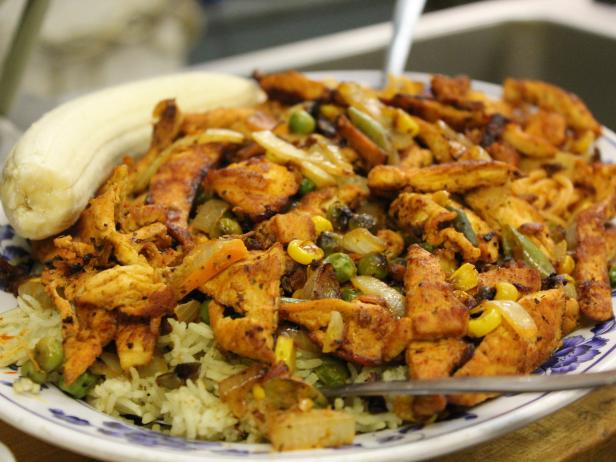Unlocking the Secrets of Somali Food: A Gastronomic Exploration of Standard Recipes and Cooking Methods
Are you ready to embark on a mouthwatering journey with the tastes and scents of Somali food? Unlocking the Tricks of Somali Cuisine: A Gastronomic Expedition of Standard Dishes and Culinary Techniques is your key to uncovering the covert treasures of this vivid culinary custom. Explore the rich background and social influences that form Somali cooking, as you discover crucial ingredients and important food preparation methods. From aromatic rice dishes to delicious meat stews, this book uses a treasure of typical recipes bied far with generations. So get your apron and prepare yourself to unlock the tricks of Somali food, one tasty bite at a time.
History of Somali Cuisine
The history of Somali cuisine go back centuries, and it is a fascinating journey that you will currently start. Somali cuisine is deeply rooted in the country's abundant social heritage and nomadic lifestyle. Throughout background, Somalis have actually relied upon their setting to maintain themselves, leading to a food that is both delicious and varied.
Centuries earlier, Somali cuisine was heavily influenced by the Arab, Persian, Indian, and Turkish investors who visited the area. These investors presented new spices, cooking techniques, and ingredients that changed Somali food right into an one-of-a-kind blend of flavors. Somali food is understood for its strong and aromatic spices, such as cumin, cinnamon, cardamom, and turmeric extract, which are used to boost the taste of dishes.

The nomadic lifestyle of the Somali individuals also played a substantial function in forming their cuisine. Standard Somali recipes often contain lamb, fish, goat, or camel, as these were easily offered to the wanderers. Dairy products, such as camel milk and ghee, are likewise staples in Somali cuisine.
For many years, Somali cuisine has developed and adjusted, including impacts from neighboring areas and nations. Today, Somali food is celebrated for its use fresh and in your area sourced active ingredients, as well as its vibrant tastes. Whether you're enjoying a sambusa (a savory pastry) or a dish of bariis (rice) skilled with aromatic spices, Somali cuisine makes sure to delight your preference buds and inform a fascinating tale of the nation's background.
Trick Active Ingredients in Somali Food Preparation
You often encounter a range of key active ingredients in Somali food preparation that add depth and taste to the meals. One such ingredient is Xawaash, an unique Somali seasoning mix that is comprised of different spices such as cumin, coriander, cardamom, cinnamon, and cloves. This fragrant blend is frequently made use of as a spices for meat, rice, and stews, providing a distinctive and savory taste.
An additional necessary ingredient in Somali food preparation is Maraq, a flavorful broth that develops the base for lots of Somali dishes (Somali food). Made by simmering meat or vegetables with flavors, herbs, and often tomatoes, Maraq adds richness and deepness to stews, soups, and sauces. It is often served together with typical bread, such as Anjero or Injera, to enhance the overall dining experience
Bananas additionally play a significant role in Somali cuisine. Whether they are utilized in full-flavored dishes like Suugo Suqaar or in desserts like Malawax, bananas offer a special sweet taste and creaminess to the meals. They are usually combined with other components such as meat, coconut, or flavors to create a harmonious balance of flavors.
Lastly, Somali cuisine includes a selection of fresh natural herbs and veggies like cilantro, parsley, onions, garlic, and tomatoes. These ingredients not only include quality and vibrancy to the recipes yet additionally add to their dietary value.
Conventional Somali Recipes
Continue your expedition of Somali food by delving right into the globe of conventional Somali dishes. These recipes have actually been given with generations, preserving the abundant flavors and culinary practices of the Somali people. One renowned dish is the Somali-style rice, additionally referred to as bariis. It is cooked with fragrant flavors like turmeric extract, cardamom, and cumin, giving it a lively yellow color and a tantalizing fragrance. Bariis is usually served with maraq, a passionate stew made with meat, vegetables, and tomato sauce.
An additional popular Somali recipe is sambusa, a deep-fried bread loaded with a full-flavored mixture of meat and vegetables. Sambusas are a precious treat and can be found at every Somali gathering. They are crunchy on the outdoors and breaking with flavorful fillings on the inside.
For those with a pleasant tooth, there is the wonderful Somali-style banana bread, referred to as khamiir. This moist and fluffy bread is made with ripe bananas, cardamom, and coconut, causing a delicious treat that is ideal for breakfast or five-o'clock tea.
Finally, check out here no discussion of conventional Somali recipes would certainly be full without mentioning suugo suqaar, a mouthwatering meal made with tender beef or hen cooked in a rich tomato sauce. It is frequently served with basmati rice or Somali flatbread, referred to as canjeero.
These standard Somali recipes provide a peek into the vibrant and varied cooking heritage of Somalia. Somali food. Each meal is a testament to the creativity and ingenuity of the Somali people, that have actually grasped the art of combining simple components to create savory and enjoyable dishes

Culinary Methods and Cooking Approaches
To recognize the ins and outs of Somali cuisine, it is important to check out the cooking techniques and cooking techniques used in traditional Somali recipes. Somali food is known for its rich tastes and unique combinations of seasonings, which are achieved with numerous food preparation techniques.
One of the most generally used food preparation methods in Somali cuisine is braising. This includes gradually cooking meat or veggies in a percentage of fluid, such as water or brew, over reduced warmth. Braising helps to tenderize tougher cuts of meat and instill them with taste.
An additional preferred strategy is frying, which is made use of to prepare a selection of meals. In Somali cuisine, frying is normally done making use of veggie oil or ghee, a made clear butter. This approach develops a crispy outside and includes an abundant, full-flavored taste to the food.
Barbecuing is likewise widely made use of in Somali food preparation, particularly for meats like goat, camel, and lamb. Grilling over an open fire gives the meat a smoky and charred taste, while preserving its all-natural juices.
In addition to these food preparation approaches, Somali cuisine additionally uses techniques like cooking, steaming, and baking. Cooking is frequently used for making hearty soups and stews, while steaming is Go Here liked for vegetables and fish. Cooking is reserved for bread and breads, such as sabaayad, a conventional Somali flatbread.
Influences on Somali Food
The impacts on Somali food can be traced back to an abundant history of profession and social interactions. Over the centuries, numerous groups have left their mark on Somali cooking traditions, leading to a distinct combination of ingredients and flavors. Among one of the most considerable impacts on Somali cuisine originates from Arab investors who introduced spices like cinnamon, cloves, and cardamom. These aromatic flavors are currently commonly used in Somali meals, including deepness and intricacy to the flavor profiles. Furthermore, Indian investors brought with them a love for rice and lentils, which are currently staples in Somali food.
The Somali coastline's proximity to the Arabian Peninsula has also had an extensive effect on the culinary landscape. Arabic flavors, such as saffron and turmeric, have actually located their method into conventional Somali meals, enhancing both the visual appeal and preference. Somali food has actually been affected by bordering countries like Ethiopia and Kenya. The Somali people have actually integrated elements of Ethiopian food, such as injera (a sourdough flatbread), into their very own cooking traditions.
In even more recent times, more Somali cuisine has actually also been influenced by Western societies. The colonial presence of the Italians has actually resulted in the unification of pasta and tomato-based sauces in Somali cooking. Somali diaspora areas in Europe and North America have presented brand-new ingredients and cooking techniques to the typical Somali repertoire.
Final Thought
Finally, Somali cuisine provides a rich and diverse cooking experience. With a background affected by profession courses and social exchanges, Somali recipes display a variety of flavors and cooking techniques. From essential ingredients like rice, flavors, and camel meat to standard dishes like bariis iskukaris and sambusa, Somali food is a reflection of the country's lively culture and heritage. Exploring the secrets of Somali cuisine is a gastronomic trip that makes certain to thrill food fanatics.
Opening the Tricks of Somali Food: A Gastronomic Expedition of Standard Recipes and Culinary Techniques is your ticket to finding the hidden prizes of this lively culinary practice.One more essential component in Somali cooking is Maraq, a flavorful brew that forms the base for several Somali meals.Proceed your expedition of Somali food by diving into the globe of conventional Somali dishes. Somali diaspora communities in Europe and North America have actually introduced new active ingredients and cooking strategies to the traditional Somali collection.
From standard ingredients like rice, spices, and camel meat to conventional dishes like bariis iskukaris and sambusa, Somali food is a reflection of the country's vivid culture and heritage.